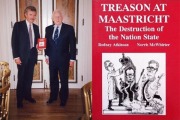PROFITEERS OF THE THIRD REICH THEREBY FINANCED
THE ADVANCE OF THE EUROPEAN UNION
Those who managed IG Farben during the War and were convicted
for heinous crimes at IG Auschwitz were quickly rehabilitated in the 1950s
and became the directors of the firms which financed Helmut Kohl.
Today within the European Union those same chemical companies,
Bayer, Hoechst and BASF have been very prominent in promoting that same “European integration” from which they profited during Nazi rule.
HELMUT KOHL:
Brother killed in Second World War. As a youth Kohl pulled down border posts between France and Germany. The prime instigator, with the (Vichy regime Nazi collaborator) Francois Mitterand of the present “Integrated Europe”. “Might is right in politics and War” he claimed. Undermined Czechoslovakia (using Hitlerite imagery of “trains” and “points”), planned the 1999 break up of Yugoslavia, driving force behind Maastricht Treaty. “The future will belong to Germans when we build the house of Europe” (1995)
I G FARBEN:
After the First World War, all the major German chemical concerns Hoechst, Bayer, BASF were merged in 1926 into a single gigantic trust – the I.G. Farbenindustrie A.G. IG Farben was the single largest donor to Adolph Hitler’s election fund, donating, one year before Hitler seized power, 400,000 Marks.
With their combined production of pharmaceuticals and explosives and their multinational operations IG Farben became not only indispensable to the German war effort but the company was engaged by the German intelligence services for spying missions abroad.
IG Farben produced Zyklon-B, a deadly gas produced by Hoechst and the prime method of extermination in Auschwitz and other camps. IG Auschwitz was a corporate installation next to (and bigger than!) the Auschwitz extermination camp itself where the company helped in the exterminations, used slave labour, tested new chemicals on inmates and carried out medical experiments from which hundreds died.
1941: I.G. Farben’s “friendship” with the SS helps to increase the speed of construction of Auschwitz-Buna against the resistance “of some little bureaucrats”. (A letter from Dr. Otto Ambros to the Director of I.G. Farben Frankfurt, Fritz ter Meer) 1944: A letterin which I.G. Farben orders “energetic punishment” for a slave laborer in Auschwitz-Monowitz. For copies of the original documentation for the above see the website
www.dr-rath-foundation.org
The U.S. government investigation of the factors that led to the Second World War in 1946 came to the conclusion that
“without IG Farben the Second World War would simply not have been possible.
We have to come to grips with the fact that it was not a psychopath, Adolph Hitler,
or bad genes of the German people that brought about the Second World War. Economic greed by companies like Bayer, BASF and Hoechst was the
key factor in bringing about the Holocaust.”
Those who managed IG Farben during the War and were convicted for heinous crimes were quickly rehabilitated in the 1950s and became the directors of the firms which financed Helmut Kohl through the Chemical Industries Association.
Kohl rose to become the leading “integrator” of the European Union (with Francois Mitterand a hero of the wartime Vichy regime, the French collaborators). They included many who were awarded prizes both by the Nazis and the post war “Federal Republic of Germany”:
Fritz ter Meer (1884-1967)
Member of the IG FARBEN executive committee 1926-1945,
As the Wartime Manager, he was responsible for IG Auschwitz.
In the Nuremberg Tribunal, ter Meer stated: “Forced labor did not inflict any remarkable injury, pain, or suffering on the detainees, particularly since the alternative for these workers would have been death.”
1948 found guilty of “plundering” and “enslavement” and condemned to seven years detention.
In 1952, his sentence was commuted, due to the influence of powerful friends.
From 1956-1964, he was reinstated as a member of the Managing Board of Bayer
Otto Ambros (1901-):
Member of the IG FARBEN executive committee 1938-1945, member of the chemical committee and chairman of commission K (intelligence agents),
Responsible for choice of location, planning, building and running of IG Auschwitz as operations manager.
1945 Nazi knight’s cross Distinguished Service Cross
1948 found guilty of “enslavement” condemned to eight years detention.
Released 1952.
From 1954: chairman, deputy chairmen and member of the boards of: Chemie Grünenthal, Pintsch Bamag AG, Knoll AG, Feldmühle Papier- und Zellstoffwerke, Telefunken GmbH, Grünzweig & Hartmann, Internationale Galalithgesellschaft, Berliner Handelsgesellschaft, Süddeutsche Kalkstickstoffwerke, Vereinigte Industrieunternehmungen (VIAG) with its daughter enterprises Scholven-Chemie and Phenol-Chemie as an advisor to F. K. Flick. – entangled in the early eighties in the “Flick scandal”
Heinrich Buetefisch (1894-1969)
Member of the IG FARBEN executive committee 1934-1945, deputy director of section I, director of gasoline synthesis for IG Auschwitz. SS Obersturmbannführer, awarded the “friend of the Reich leader SS” cross.
1948 found guilty of “enslavement” condemned to six years detention.
1964 Distinguished Service Cross of the Federal Republic of Germany (but the award was taken back after 16 days due to the violent protests)
Friedrich Jaehne (1879-1965)
Member of the IG FARBEN executive committee 1934-1945. Chief engineer.
1943 Nazi “military industrial leader”, Distinguished Service Cross 1st. Class
1948 found guilty of “plundering” condemned to 18 months detention
1955 supervisory board member of the “new” Farbwerke Hoechst.
1962 Bayer service medal, honorary senator of TH Munich, Distinguished Service Cross of the Federal Republic of Germany
Carl Wurster (1900-1974)
Member of the IG FARBEN executive committee 1938-1945,
1945 Nazi Distinguished Service Cross
1952 chairman of the board of the “new” BASF.
1955 Distinguished Service Cross of the Federal Republic of Germany,
1967 Schiller Prize of the city of Mannheim, President of the Chemical Industry Federation.
With the direct support of such people:
HELMUT KOHL BEGINS HIS ADVANCE
From 1957 to 1967 the young Helmut Kohl, a local politician from the BASF town of Ludwigshafen, was a paid lobbyist of the Chemical Industry Association (Verband Chemischer Industrie) the central lobby organization of the German
pharmaceutical and chemical cartel consisting predominantly of the same companies which had been part of I G Farben.
Thus, the German chemical and pharmaceutical industry built up one of its own as a political representative. It paid off! Helmut Kohl was chancellor of Germany for 16 years and the German pharmaceutical and chemical industry became the world’s leading exporter of chemical products, with subsidiaries in over 150 countries, more than IG Farben ever had.
Today within the European Union chemical companies like Bayer, Hoechst and BASF have been very prominent in the promotion of that same “European integration” from which they profited during Nazi rule.
FURTHER DOCUMENTATION ON IG FARBEN IN AUSCHWITZ:
(see www.dr-rath-foundation.org)
On April 14, 1941, in Ludwigshafen, Otto Armbrust, the IG Farben board member responsible for the Auschwitz project, stated to his IG Farben board colleagues, “our new friendship with the SS is a blessing. We have determined all measures integrating the concentration camps to benefit our company.”
The pharmaceutical departments of the IG Farben cartel used the victims of the concentration camps in their own way: thousands of them died during human experiments such as the testing of new vaccines.
There was no retirement plan for the prisoners of IG Auschwitz. Those who were too weak or too sick to work were selected at the main gate of the IG Auschwitz factory and sent to the gas chambers.
Scientific experiments were also done in other concentration camps. A decisive fact is that IG employee SS major Dr. med. Helmuth Vetter, stationed in several concentration camps, participated in these experiments by order of Bayer Leverkusen.
Dr. Joseph Mengele, experimented in Auschwitz with medications that were designated “B-1012″, B-1034”, “3382” or “Rutenol”. The test preparations were not just applied to those prisoners who were ill, but also to healthy ones. These people were first infected on purpose through pills, powdered substances, injections or enemas. Many of the medications caused the victims to vomit or have bloody diarrhoea. In most cases the prisoners died as a result of the experiments.
(from the book “I.G. Farben – from Anilin to forced labor” by Jörg Hunger and Paul Sander)
In the Auschwitz files correspondence was discovered between the camp commander and Bayer Leverkusen. It dealt with the sale of 150 female prisoners for experimental purposes: “With a view to the planned experiments with a new sleep-inducing drug we would appreciate it if you could place a number of prisoners at our disposal (…)” – “We confirm your response, but consider the price of 200 RM per woman to be too high. We propose to pay no more than 170 RM per woman. If this is acceptable to you, the women will be placed in our possession. We need some 150 women (…)” –
“We confirm your approval of the agreement. Please prepare for us 150 women in the best health possible (…)” – “Received the order for 150 women. Despite their emaciated condition they were considered satisfactory. We will keep you informed of the developments regarding the experiments (…)” – “The experiments were performed. All test persons died. We will contact you shortly about a new shipment”
A former Auschwitz prisoner testified: 150 Jewish women that had been bought from the camp attendant by Bayer, (…) served for experiments with unknown hormonal preparations.”
Parallel to the tests by Behringwerke and Bayer Leverkusen the chemical-pharmaceutical and serologic-bacteriological department at Hoechst started experimenting on Auschwitz prisoners with their new typhus fever preparation “3582”. The first series of tests had results that were far from satisfactory. Of the 50 test persons 15 died; the typhus fever drug led to vomiting and exhaustion. Part of the concentration camp Auschwitz was quarantined, which led to an extension of the tests to the concentration camp in Buchenwald.
In the journal of the “Department for typhus fever and viral research of the concentration camp Buchenwald” we find on January 10th, 1943: “As suggested by the IG Farbenindustrie A.G. the following were tested as typhus fever medications: a) preparation 3582 <Akridin> of the chem. pharm. and sero-bact. Department Hoechst – Prof. Lautenschläger and Dr. Weber – (therapeutic test A), b) methylene blue, formerly tested on mice by Prof. Kiekuth, Elberfeld (therapeutic test M).”
The SS physician Dr. Hoven testified during the Nuremberg Trial: “It should be generally known, and especially in German scientific circles, that the SS did not have notable scientists at its disposal. It is clear that the experiments in the concentration camps with IG preparations only took place in the interests of the IG, which strived by all means to determine the effectiveness of these preparations. They let the SS deal with the – shall I say – dirty work in the concentration camps. It was not the IG’s intention to bring any of this out in the open, but rather to put up a smoke screen around the experiments so that (…) they could keep any profits to themselves. Not the SS but the IG took the initiative for the concentration camp experiments.”
Most of the above information comes from the website www.dr-rath-foundation.org















